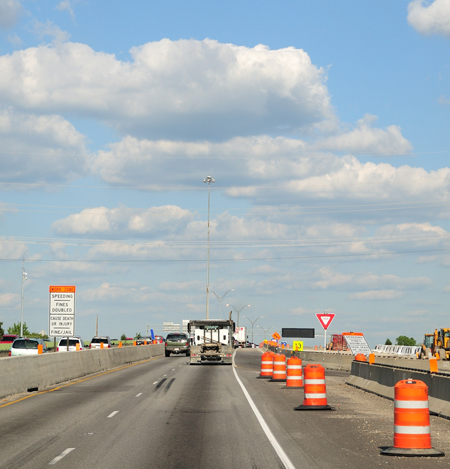|
How to Prevent Work Zone Crashes
Due to the increased frequency of road maintenance and construction projects during the summertime, it is critical that drivers always be on the lookout for upcoming highway work zones. Even if they have planned their route to avoid work zones, drivers must still be on high alert for any that may have been set up suddenly. Drivers should also keep in mind that many states have increased penalties in place for speeding and other traffic violations committed in highway work zones.

Work zones present many hazards, including smaller lanes of travel and confused or frustrated motorists. The changing traffic patterns may be difficult for some motorists to adjust to, particularly at night when it is difficult to determine how temporary lanes are laid out. Commercial motor vehicle (CMV) drivers have a much higher point of view than those of smaller vehicles and should use this to their advantage. The ability to look further ahead at the developing traffic conditions allows CMV drivers to prepare and may provide an opportunity to respond early enough to avoid a collision.
Many work zone collisions occur in the area immediately prior to the actual work zone where traffic becomes significantly congested and may stop suddenly without notice. For this reason, drivers must be alert from the first sign notifying them of an upcoming work zone and use caution throughout. In addition to watching for unpredictable motorists, drivers should also stay on the lookout for construction workers and large equipment inadvertently entering their lane of travel.
Every highway work zone is made up of five key areas designed to maximize the safety of the workers and motorists driving through the vicinity.
- Advance Warning Areas tell drivers what to expect in enough time to adjust their driving.
- Transition Areas channel drivers into a new path.
- Buffer Areas provide safety zones for drivers and workers. This is the open, unoccupied space between the transition area and the work area.
- Work Areas are closed to traffic and occupied by workers, equipment and material.
- Termination Areas provide a short distance for traffic to clear the work area and return to normal traffic flow.
According to the National Work Zone Safety Information Clearinghouse, the number of large trucks involved in work zone crashes decreased significantly from 2005 to 2009 (the most recent data available). In 2005, 289 large trucks were involved in these crashes. By 2009, this number had declined 45 percent to only 159. While this was a tremendous achievement, your company must remain committed to improving safety and promoting awareness of proper driving techniques through work zones.
Provide your drivers with these 10 simple reminders to help them as they drive through an increased number of work zones this summer:
- Expect the unexpected.
- Slow down. Always abide by the posted speed limit.
- Don’t tailgate. Double following distance.
- Stay a safe distance from construction workers and their equipment.
- Pay attention to posted signs.
- Watch for traffic that may be stopped ahead.
- Be alert and minimize distractions.
- Obey road crew flaggers.
- Schedule enough time for delays. Check radio, TV and websites for traffic information.
- Be patient and stay calm.
Your safety department and dispatchers should have access to resources that will allow them to help drivers plan routes around work zones and warn drivers on the road about upcoming work zones. Software and websites are available to assist your staff in preparing drivers and keeping them safe as they approach work zones throughout their routes.
To help remind your drivers to travel safely through highway work zones, Baldwin & Lyons is offering free copies of our Tips for Driving Safely through Highway Work Zones handout card and a Highway Work Zone Ahead! Five Key Areas poster, while supplies last. To order these resources, contact the Loss Prevention Resource Library at 317-636-9800 or email your request to thequill@baldwinandlyons.com.
Please refer to the Resource Library for video training programs that will enhance safe driving through work zones.
{ back } |
